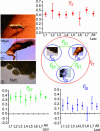"Clonal" population structure of the malaria agent Plasmodium falciparum in high-infection regions
- PMID: 16301534
- PMCID: PMC1297693
- DOI: 10.1073/pnas.0508871102
"Clonal" population structure of the malaria agent Plasmodium falciparum in high-infection regions
Abstract
The population genetic structure of Plasmodium falciparum, the agent of malignant malaria, has been shown to be predominantly "clonal" (i.e., highly inbred) in regions of low infectivity; in high-infectivity regions, it is often thought to be panmictic, or nearly so, although there is little supporting evidence for this. The matter can be settled by investigating the parasite's genetic makeup in the midgut oocysts of the mosquito vector, where the products of meiosis can directly be observed. The developmental stages of P. falciparum are haploid, except in the oocysts of infected mosquito vectors, where two gametes fuse, diploidy occurs, and meiosis ensues. We have investigated genetic polymorphisms at seven microsatellite loci located on five chromosomes by assaying 613 oocysts in 145 mosquitoes sampled from 11 localities of Kenya, where malignant malaria is perennial and intense. There is considerable allelic variation, 16.3 +/- 2.1 alleles per locus, and considerable inbreeding, approximately 50% on the average. The inbreeding is caused by selfing (approximately 25%) and nonrandom genotype distribution of oocysts among mosquito guts (35%). The observed frequency of heterozygotes is 0.43 +/- 0.03; the expected frequency, assuming random mating, is 0.80 +/- 0.05. Linkage disequilibrium is statistically significant for all 21 pairwise comparisons between loci, even though 19 comparisons are between loci in different chromosomes, which is consistent with strong deviation from panmixia and the consequent reproduction of genomes as clones, without recombination between gene loci. This is of considerable evolutionary significance and of epidemiological consequence, concerning the spread of multilocus drug and vaccine resistance.
Figures


References
-
- Hartl, D. L., Volkman, S. K., Nielsen, K. M., Barry, A. E., Day, K. P., Wirth, D. F. & Winzeler, E. A. (2002) Trends Parasitol. 18, 266–272. - PubMed
-
- Korenromp, E. L., Williams, B. G., Gouws, E., Dye, C. & Snow, R. W. (2003) Lancet Infect. Dis. 3, 349–358. - PubMed
-
- Paul, R. E. L., Ariey, F. & Robert, V. (2003) Ecol. Lett. 6, 866–880.
-
- Anderson, T. J. C., Haubold, B., Williams, J. T., Estrado-Franco, J. G., Richardson, L., Mollinedo, R., Bockarie, M., et al. (2000) Mol. Biol. Evol. 17, 1467–1482. - PubMed

